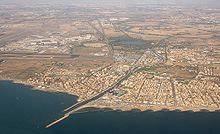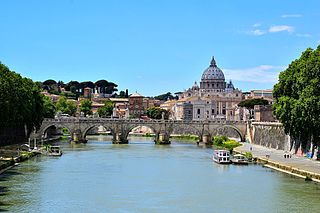
The Tiber is the third-longest river in Italy and the longest in Central Italy, rising in the Apennine Mountains in Emilia-Romagna and flowing 406 km (252 mi) through Tuscany, Umbria, and Lazio, where it is joined by the River Aniene, to the Tyrrhenian Sea, between Ostia and Fiumicino. It drains a basin estimated at 17,375 km2 (6,709 sq mi). The river has achieved lasting fame as the main watercourse of the city of Rome, which was founded on its eastern banks.

Ostia Antica was an ancient Roman city and the port of Rome located at the mouth of the Tiber River. It is near modern Ostia, 25 kilometres southwest of Rome. Due to silting and the invasion of sand, the site now lies 3 km (2 mi) from the sea. The name Ostia derives from Latin os 'mouth'.

Isola del Giglio, or Giglio Island in English, is an Italian island and comune (municipality) in the Tyrrhenian Sea, off the coast of Tuscany, and is part of the Province of Grosseto. The island is one of seven that form the Tuscan Archipelago, lying within the Arcipelago Toscano National Park. Giglio means "lily" in Italian, and though the name would appear consistent with the insignia of Medici Florence, it originally derives from the Latin name of the island, Igilium, which in turn could be related to the Ancient Greek name of the neighbouring Capraia, Αἰγύλιον, from αἴξ aíx "goat".

Fiumicino is a town and comune in the Metropolitan City of Rome, Lazio, central Italy, with a population of 80,500 (2019). It is known for being the site of Leonardo da Vinci–Fiumicino Airport, the busiest airport in Italy and the eleventh-busiest in Europe.

Civitavecchia is a city and comune of the Metropolitan City of Rome in the central Italian region of Lazio. A sea port on the Tyrrhenian Sea, it is located 60 kilometres west-north-west of Rome. The harbour is formed by two piers and a breakwater, on which stands a lighthouse.

Via Severiana was an ancient Roman road in central Italy leading in Latium, running southeast from Portus to Tarracina, a distance of 80 Roman miles along the coast. A restoration and reunion of existing roads was carried out with a work of lastrification in 198–209 AD, during the reign of emperor Septimius Severus, in order to connect more quickly the maritime towns of Ostia, Lavinium, Ardea, Antium and the routes that came there from Rome.
Via Portuensis was an ancient Roman road, leading to the Portus constructed by Claudius on the right bank of the Tiber, at its mouth. It started from the Pons Aemilius, and the first part of its course is identical with that of the Via Campana. The Porta Portuensis of the Aurelian Walls had a double arch, probably owing to the amount of traffic it had to carry, but the divergence occurred a good deal further on, probably a mile from the gate. The Via Portuensis went to the right into hilly country, while the Via Campana kept to the valley of the Tiber. The roads rejoined at the modern Ponte Galeria.

The Via Ostiensis was an important road in ancient Rome. It ran west 30 kilometres (19 mi) from the city of Rome to its important sea port of Ostia Antica, from which it took its name. The road began near the Forum Boarium, ran between the Aventine Hill and the Tiber River along its left (eastern) bank, and left the city's Servian Walls through the Porta Trigemina. When the later Aurelian Walls were built, the road left the city through the Porta Ostiensis. In the late Roman Empire, trade suffered under an economic crisis, and Ostia declined as an important port. With the accompanying growth of importance of the Via Portuensis from the time of Constantine onwards, that of the Via Ostiensis correspondingly decreased. Modern Via Ostiense, following a similar path, is the main connection of Rome to Ostia together with the Via del Mare. On its way to Ostia, the road passes by the important basilica of Saint Paul Outside the Walls.

Ostia Antica is the 35th zona of Rome, Italy, four kilometers away from the coast. It is identified by the initials Z. XXXV and it is distinct from Ostia. Ostia Antica belongs to Municipio X.

Ostia is a large neighbourhood in the X Municipio of the comune of Rome, Italy, near the ancient port of Rome, which is now a major archaeological site known as Ostia Antica. Ostia is also the only municipio or district of Rome on the Tyrrhenian Sea, and many Romans spend the summer holidays there.

Isola Sacra is situated in the Lazio region of Italy south of Rome, near the Tyrrhenian Sea. It is part of the town of Fiumicino.
Caligula's "Giant Ship", also known as the "Round Ship", was a very large barge, the ruins of which were found during the construction of Rome's Leonardo da Vinci International Airport in Fiumicino, Italy, in the 1950s. This was previously a Roman port a few kilometres north of Ostia at the mouth of the Tiber River. The ship was dated to c. 37 AD using dendrochronological dating methods.
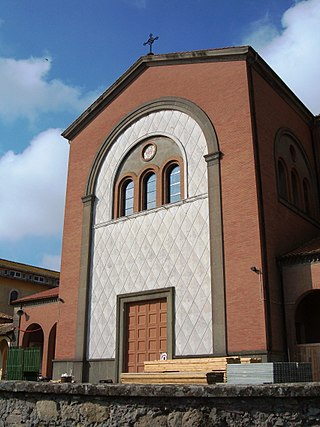
The Diocese of Porto–Santa Rufina is a suburbicarian diocese of the Diocese of Rome and a diocese of the Catholic Church in Italy. It was formed from the union of two dioceses. The diocese of Santa Rufina was also formerly known as Silva Candida.

The Isola Sacra Necropolis was the first large-scale pagan cemetery of Roman Imperial times to be excavated. The excavator-in-chief of most of Isola Sacra was Guido Calza. The necropolis was found on the manmade island of Isola Sacra, which lies between the cities of Portus and Ostia Antica, a region just south of Rome. The emperor Trajan was in power when this artificial island was created. Much of the excavated necropolis flanked the Via Severiana, which ran through Isola Sacra and traveled southeast from Ostica to Terracina.

Porta Portese is an ancient city gate, located at the end of Via Portuense, where it meets Via Porta Portese, about a block from the banks of the Tiber in the southern edge of the Rione Trastevere of Rome, Italy.

Circeii was an ancient Roman city on the site of modern San Felice Circeo and near Mount Circeo, the mountain promontory on the southwest coast of Italy. The area around Circeii and Mount Circeo was thickly populated with Roman villas and other buildings, of which the remains of many can still be seen.
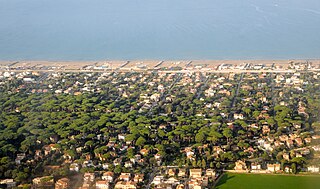
Fregenae, was a maritime town of ancient Etruria, situated between Alsium and the mouth of the Tiber. The modern Fregene is an Italian hamlet (frazione) of Fiumicino, in the Metropolitan City of Rome, Lazio. As of 2012 its population was of 6,445.
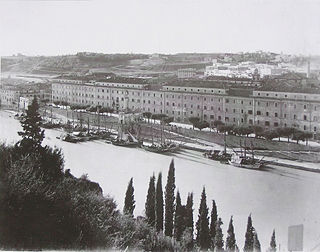
Porto di Ripa Grande was the river port of Rome, just downstream the former Pons Sublicius, where the wares, going up and down the Tiber towards the dock of Fiumicino, were handled. The building of the muraglioni has erased its existence and function, just keeping a trace in the toponymy and in the two ramps giving access to the quay of the river.

The zones of Rome are toponymic subdivisions within the area of the Ager Romanus, belonging to the Municipalities of Rome and Fiumicino, Italy.

The Litorale Romano state nature reserve is a protected area in Lazio (Italy), established by the Ministry of the Environment with Ministerial Decree of March 29, 1996, which includes a large territory of historical-naturalistic interest within the municipalities of Rome and Fiumicino.
With its over 17,000 hectares, discontinuously distributed along the Lazio coast between Palidoro and Capocotta, it is the largest protected area overlooking the Mediterranean Sea. Its management is entrusted to the two municipalities in their respective sections of competence.
